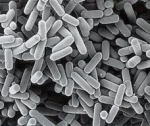So having successfully made about 6 of 11 beers or ciders so far, I naturally decided now I was ready step to it up a notch, ha.
 I’d recently made some sauerkraut. Sauerkraut ferments via lacto-fermentation. A gross oversimplification would be: the cabbage naturally has lactobacillus bacteria (LAB) living on its surface. When the cabbage is subjected to some salt and water to make it sweat, the LAB gets to work fermenting it, and two weeks to several months later you have sauerkraut.
I’d recently made some sauerkraut. Sauerkraut ferments via lacto-fermentation. A gross oversimplification would be: the cabbage naturally has lactobacillus bacteria (LAB) living on its surface. When the cabbage is subjected to some salt and water to make it sweat, the LAB gets to work fermenting it, and two weeks to several months later you have sauerkraut.
Many sour beers are also soured through lacto-fermentation. The bacteria eats the wort and produces lactic acid, leading to a drop in ph in the finished beer. Historically, LAB (usually accompanied by members of the bacteria genus pediococcus, the yeast brettanomyces, and any number of other wild yeasts) showed up in the wort through contact with materials, equipment, and even the air where the beer was being brewed and began to grow in the product. Over time, and with a better understanding of germ theory, brewers were able to do this intentionally. That subject is an interesting one that I recommend reading up on, though its certainly beyond my scope.
 There are of course many strains of lactobacillus, and brewers have tried to make beer with all of them. The strain that typically makes sauerkraut isn’t a very popular one to use with beer, but it is possible.
There are of course many strains of lactobacillus, and brewers have tried to make beer with all of them. The strain that typically makes sauerkraut isn’t a very popular one to use with beer, but it is possible.
I’d also recently started trying to wash yeast. It’s generally accepted that due to the fact that dry malt extract isn’t cheap and that dry yeast isn’t very expensive, that it usually isn’t worth using a starter to try to propagate more yeast for the dry yeast brewer, and you’ll reduce risk for only a small increase in cost of your batch to just pitch more fresh dry yeast. Keep in mind also that I only brew 1 gallon batches, so we’re not talking about a lot of yeast here. Regardless, the idea intrigues me. I always consider a lot of what I do in my micro-batches to be affording me the chance to learn, experiment, and hone my skills with small risk, which I can hopefully one day use on larger batches.

I had a packet of WB-06 that was a) already opened for a month and b) expiring in three months, so the viable cell count was probably not as good as it could be. I also had a little bit of washed WB-06 saved from my last wheat batch. I figured if I try to do a starter with the harvested yeast, and rehydrate the leftover dry yeast, I should get a decent cell count.
This will be an experimental beer on several layers. However, as any good scientist knows, a good experiment would have a control, and would be able to isolate individual variables. For my purposes here, that would require four batches:
- A wheat beer with an appropriately measured pitch rate of fresh WB-06
- A lacto-soured beer of the same grain bill with an appropriately measured pitch of WB-06
- A beer of the same grain bill with a starter calculated to an appropriate pitch rate made of harvested WB-06
- A lacto-soured beer of the same grain bill with a starter calculated to an appropriate pitch rate made of harvested WB-06
Instead I plan to:
- Try two new techniques at once on one batch with no control to compare it to.
My apologies to scientists everywhere.
(Meanwhile, if you’re in to beer experiments, the guys at Brulosophy have a ton [116 at the time of this posting] of Exbeeriments which I find fascinating.)
 Step one will be to culture some lactobacillus. I sanitize everything involved, take a spoonful of brine from my sauerkraut, and add it to some warm apple juice, seal it, and put it on top of the fridge. Within a few days there’s some weird sedimentation taking place, still not sure what that was about. Another few days later the culture has developed a pellicle. I scour the internet looking for lacto pellicles and mine looks right. I give it a whiff every few days, and it smells sour, and like apple juice. No gross funky, vomit, or other awful smells. I let it grow on top of the fridge for about two weeks in preparation for my beer.
Step one will be to culture some lactobacillus. I sanitize everything involved, take a spoonful of brine from my sauerkraut, and add it to some warm apple juice, seal it, and put it on top of the fridge. Within a few days there’s some weird sedimentation taking place, still not sure what that was about. Another few days later the culture has developed a pellicle. I scour the internet looking for lacto pellicles and mine looks right. I give it a whiff every few days, and it smells sour, and like apple juice. No gross funky, vomit, or other awful smells. I let it grow on top of the fridge for about two weeks in preparation for my beer.
Continue on to Berliner Weisse mash day for part two!


One thought on “Lacto sour beer, planning”